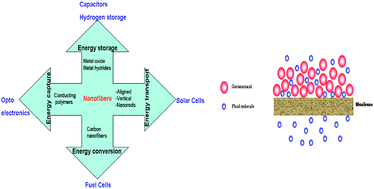Nanotechnology is providing new solutions and opportunities to ensure sustainable energy and environments for the future. Materials of nanofiberous morphology are attractive to solve numerous energy and environmental issues. Nanofibers can be effectively produced by electrospinning, which is a simple and low cost technique. In addition, electrospinning allows the production of nanofibers from various materials e.g. organics and inorganics in different configurations and assemblies. This is highly beneficial for energy devices, where inorganic materials especially metal oxides can be synthesized and electrospun, improving conducting and ceramic properties. Excitonic solar cells fabricated with aligned nanofiberous metal oxide electrodes provide higher solar–electric energy conversion efficiency, whereas fuel cells made with nanofiberous electrodes enable uniform dispersion of catalysts, and thus increase electrocatalytic activity to obtain higher chemical–electric energy conversion efficiency. The nanofibers used in filtration membranes for environmental remediation, minimize the pressure drop and provide better efficiency than conventional fiber mats. The large surface area-to-volume ratio of nanofiber membranes allows greater surface adsorption of contaminants from air and water, and increases the life-time of the filtration media. This review highlights the potential and application of electrospun nanofiberous materials for solving critical energy and environmental issues.

You have access to this article
 Please wait while we load your content...
Something went wrong. Try again?
Please wait while we load your content...
Something went wrong. Try again?


 Please wait while we load your content...
Please wait while we load your content...